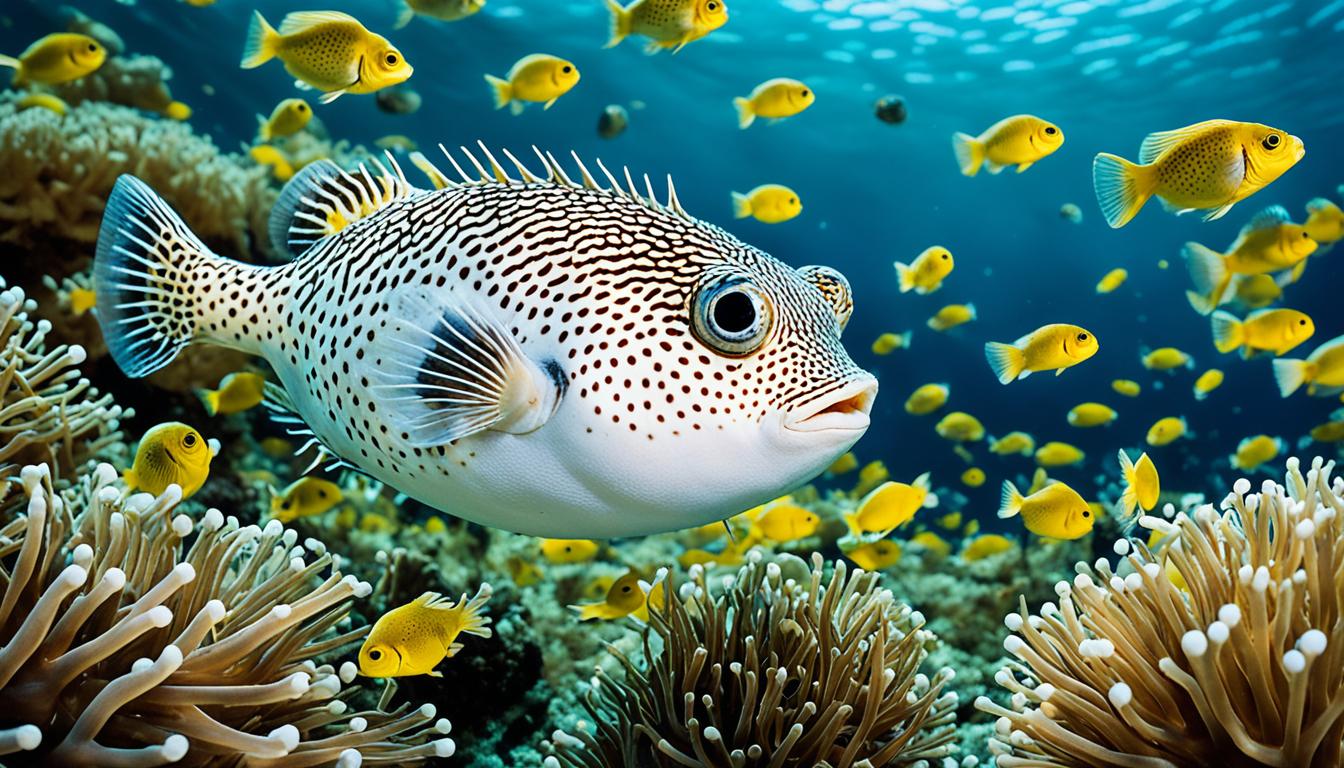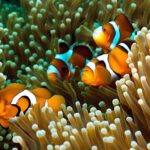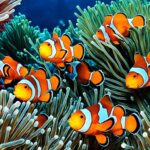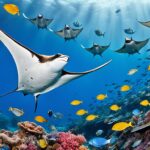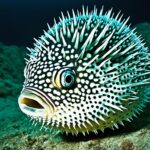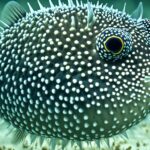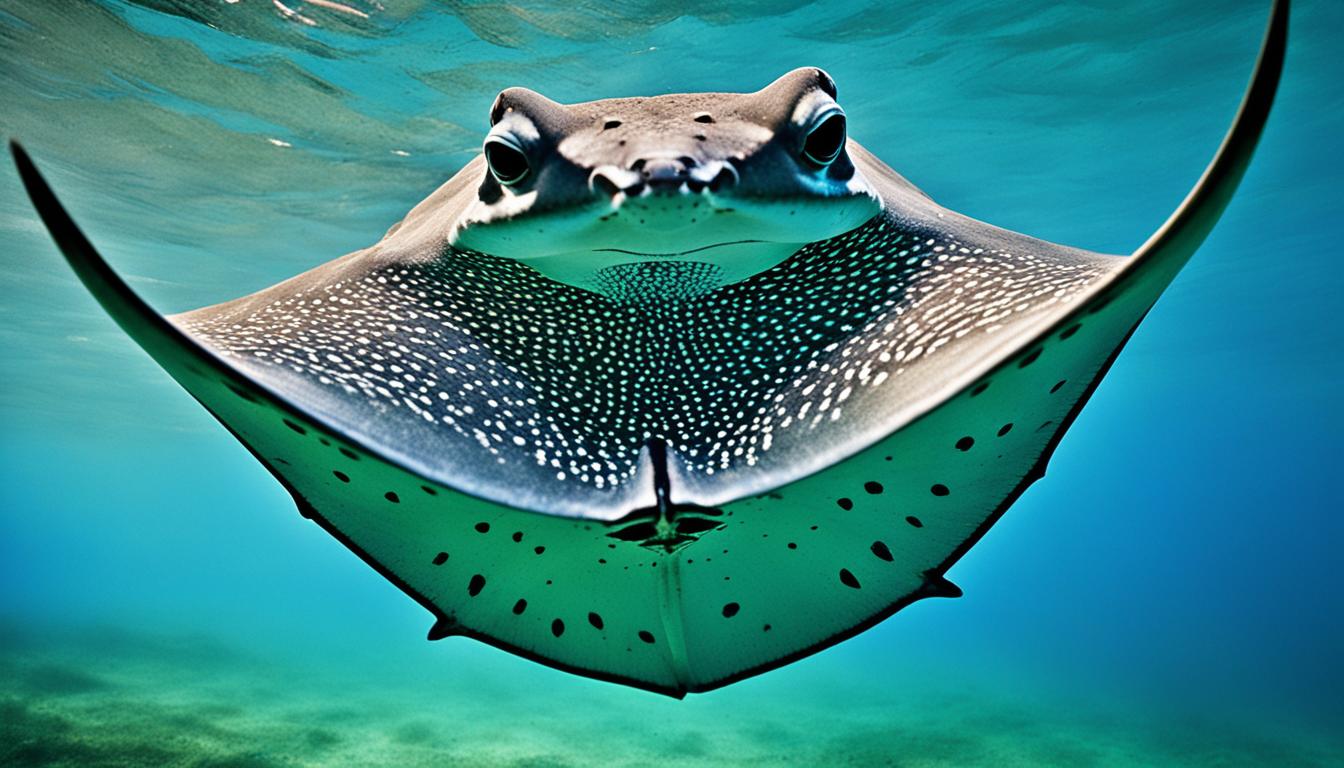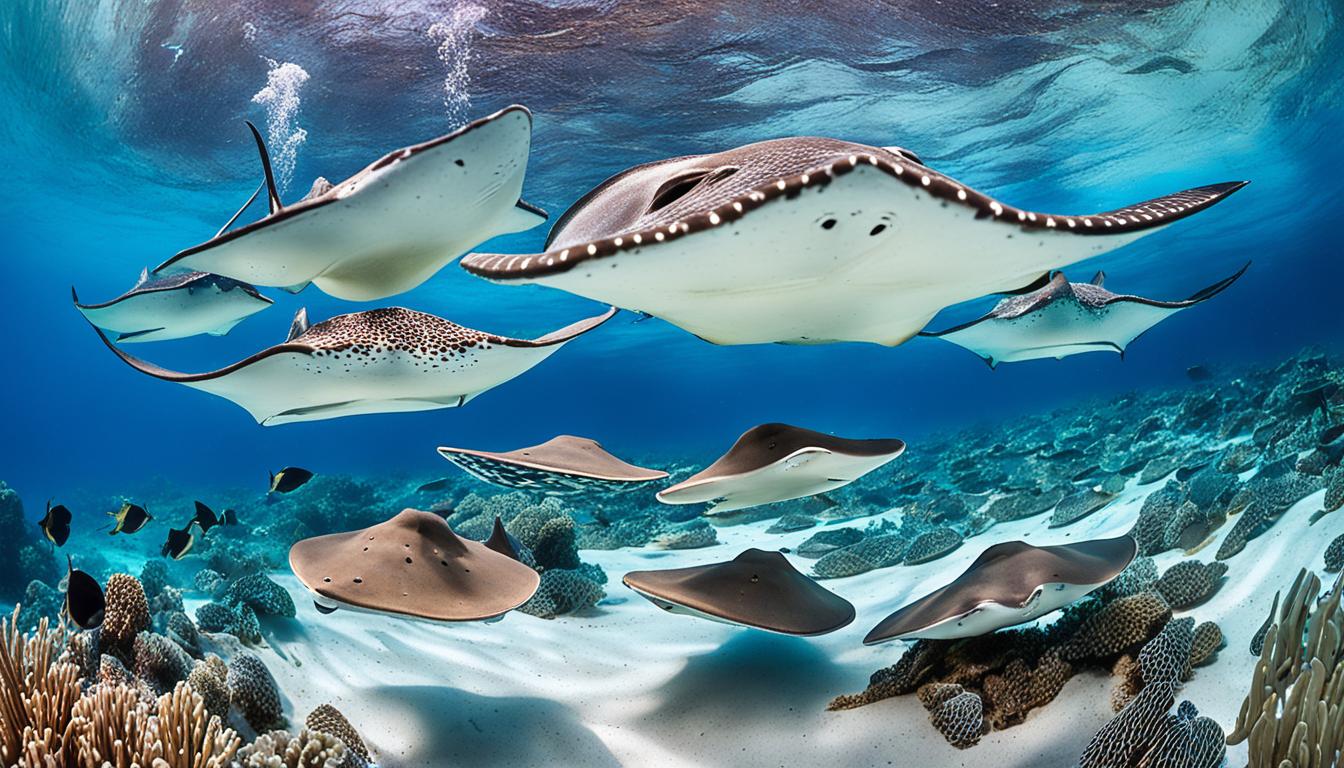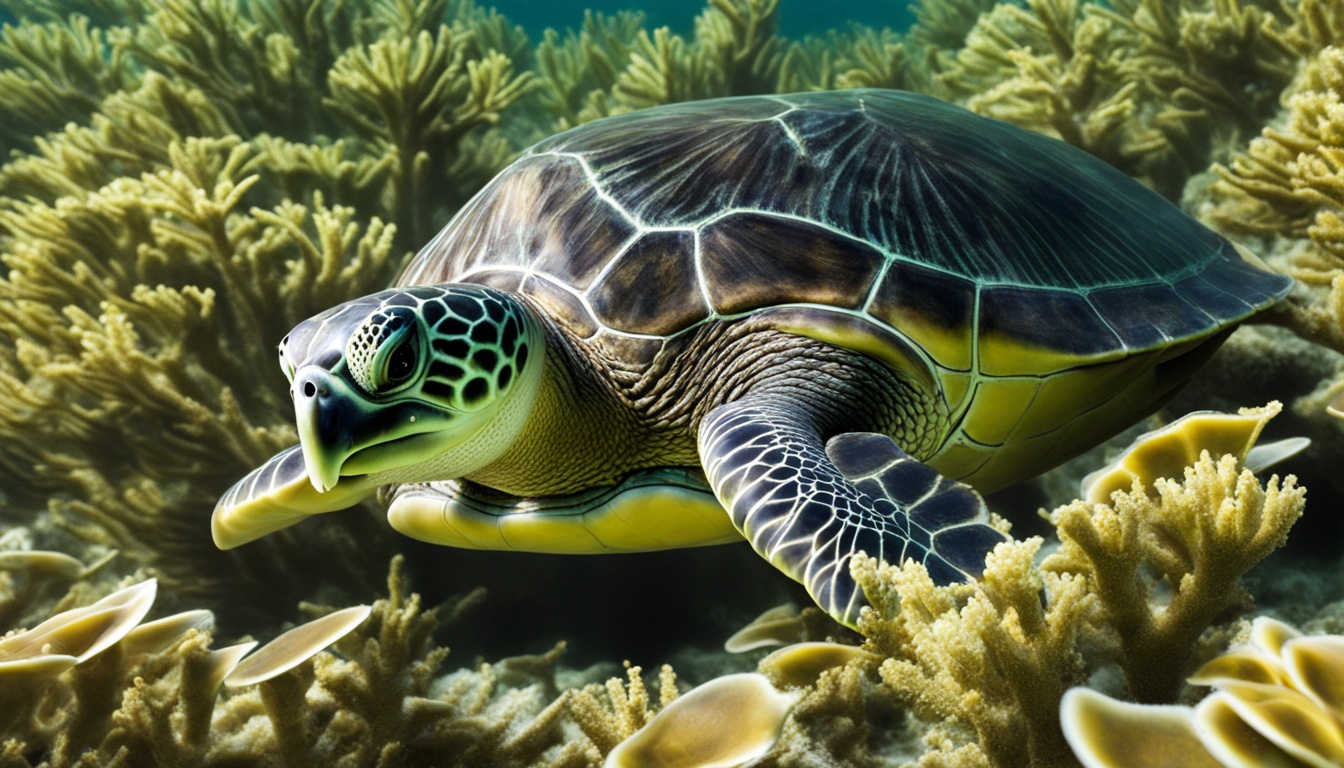Pufferfish, part of the family Tetraodontidae, show interesting ways of interacting with other sea creatures. They have special behaviors and adaptations that help keep the ocean’s balance. Let’s dive into how these unique fish interact, defend themselves, and talk to other sea beings. This will show us the complex world of marine life.
Introduction to Pufferfish Interactions in Marine Ecosystems
Pufferfish have amazing adaptations that help them in different marine ecosystems. They live mostly in warm waters and can puff up to protect themselves from predators. This defense method also changes how they interact with others in the sea.
Pufferfish live in many places, from colorful coral reefs to deep ocean areas. Their ability to adapt shows how important they are in the ocean. They play a big part in the food web as both hunters and the hunted. Learning about pufferfish helps us understand the ocean’s balance and its variety of life.
There are over 120 types of pufferfish, each with its own role in the ocean. Their ways of surviving show how crucial they are to the ecosystem. Exploring pufferfish reveals how they connect with other sea creatures in complex ways.
Understanding Pufferfish Behavior Towards Other Marine Creatures
Pufferfish have fascinating behaviors that shape their world. They interact with other sea creatures in ways that are crucial for ocean health. Learning about these interactions helps us see how vital they are to the ocean.
The role of pufferfish in ocean habitats
Pufferfish play a key role in keeping the ocean in balance. They eat invertebrates and algae, which helps control their numbers. Some pufferfish can even open shells to get to the food inside, preventing some species from taking over.
They are like nature’s indicators of ocean health. Their presence tells us about the health of marine life.
Defensive mechanisms against predators
Pufferfish have clever ways to stay safe. One way they protect themselves is by puffing up to look bigger. This makes it hard for predators to eat them. They also have a toxin that can be deadly to predators.
This toxin makes them a tough target. Their color warns predators of the danger they pose. This stops predators from trying to eat them.
How do pufferfish interact with other marine life?
Pufferfish are key players in the ocean, showing unique behaviors that shape their relationships with other sea creatures. They have special traits like toxicity and coloration that affect how they interact with others. These traits play a big role in how they deal with predators and other sea animals.
Influence of toxicity on predator-prey relationships
Pufferfish are known for being toxic due to the tetrodotoxin in their bodies. This toxin keeps predators away, making it a safe space for pufferfish. When predators get sick from eating pufferfish, they learn to stay away. This helps pufferfish live longer and keeps the balance in the ocean’s food chain.
The importance of pufferfish coloration in interactions
Pufferfish come in many colors and patterns, which are crucial for their survival. Bright colors warn predators of their toxicity. On the other hand, dull colors help them hide from predators. These colors are key for defense and communication with other sea creatures.
Changes in pufferfish color can also show stress or changes in their environment. This helps other sea animals understand what’s happening in their world.
Pufferfish Social Behavior in Ocean Ecosystems
Pufferfish show a wide range of social behaviors in their ocean homes. Some like to be alone, while others enjoy being in groups. This depends on the type of pufferfish and the environment they live in. Being alone or in a group helps them stay safe from predators.
Rituals are key to how pufferfish interact with each other. These include:
- Color Displays: Some pufferfish change color to show their status or interest in mating. This can draw in potential mates.
- Inflation Mechanism: When scared, pufferfish puff up to scare off predators. This can also send messages to other pufferfish.
- Territorial Behaviors: Pufferfish mark their territory to avoid fights with others.
Learning about pufferfish social behaviors helps us understand how they survive in different ocean settings. By studying these behaviors, we see their importance in the ocean’s ecosystem.
| Behavior Type | Description | Function |
|---|---|---|
| Solitary | Pufferfish often live alone, seeking shelter and resources independently. | Minimizes competition for food and space. |
| Schooling | Some species form schools to evade predators. | Improves survival rates through coordinated movements. |
| Color Rituals | Displays of color variations during mating rituals. | Enhances attraction of mates and establishes social hierarchies. |
| Inflation | Defense mechanism where pufferfish inflate their bodies. | Discourages potential predators from attacking. |
Marine Life Dynamics of Pufferfish Behavior
Pufferfish play a key role in the ocean’s life. Their group behaviors, like schooling, help them survive. By studying these behaviors, we learn how pufferfish live in the ocean.
Group dynamics and schooling behavior
Pufferfish form schools to adapt to their ocean home. In schools, they boost their defense against predators. This makes them safer and more likely to survive threats.
- Increased safety through collective vigilance
- Confounding predators with multiple targets
- Enhanced communication among schooling pufferfish
Studies on pufferfish schooling show many benefits:
| Advantage | Description |
|---|---|
| Reduced Predation Risk | Schools make it hard for predators to pick out a single fish. |
| Increased Foraging Efficiency | Together, pufferfish can find food more easily. |
| Enhanced Awareness | Being in a group makes pufferfish more aware of their surroundings. |
The Relationship Between Pufferfish and Other Sea Life
Pufferfish have a complex relationship with other sea creatures. They are both hunters and hunted in the ocean. Their ability to puff up is a defense against danger and affects ocean life.
Pufferfish help keep the ocean healthy by interacting with other species. Their health can show how well their home is doing. They also have special friendships, like with cleaner fish that clean them.
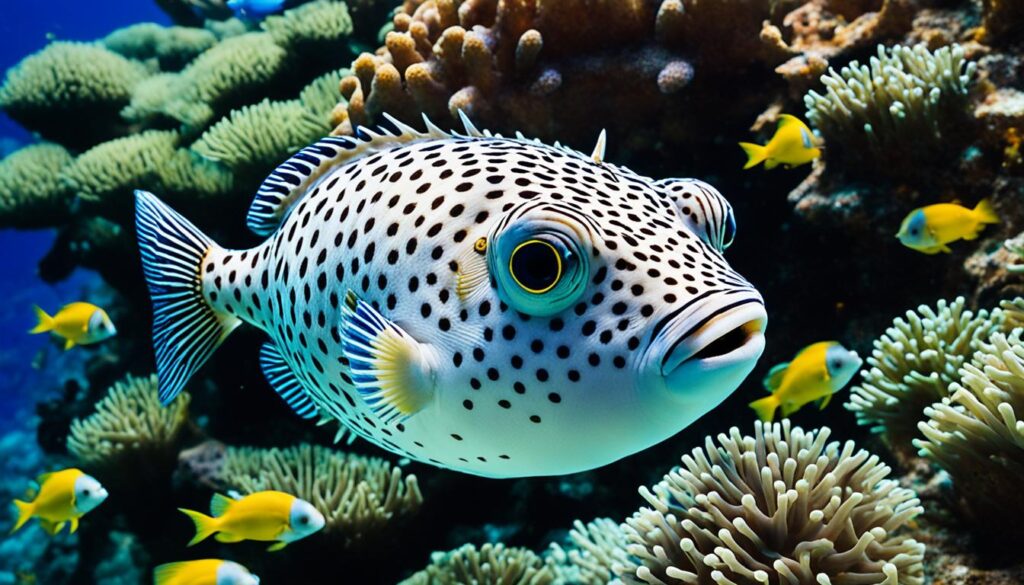
Pufferfish play a big role in ocean communities. They are important for their own survival and for others. Their relationships show how all sea life is connected. This helps us understand the ocean better.
Pufferfish Communication with Other Marine Organisms
Pufferfish play a key role in the complex world of marine life. They use behaviors like changing color and postures to talk to other creatures. This helps them send important messages, like warnings about danger or the presence of predators.
They also use how they swim to communicate. Swimming calmly can mean they’re looking for food. But swimming quickly can mean they’re alert to a threat. These behaviors help them get along with other sea creatures.
The importance of their communication can’t be ignored. It keeps the ocean’s ecosystem in balance. It helps different sea species talk to each other. By learning more, you’ll see how the pufferfish’s special ways of communicating help it survive and connect with others in the sea.

